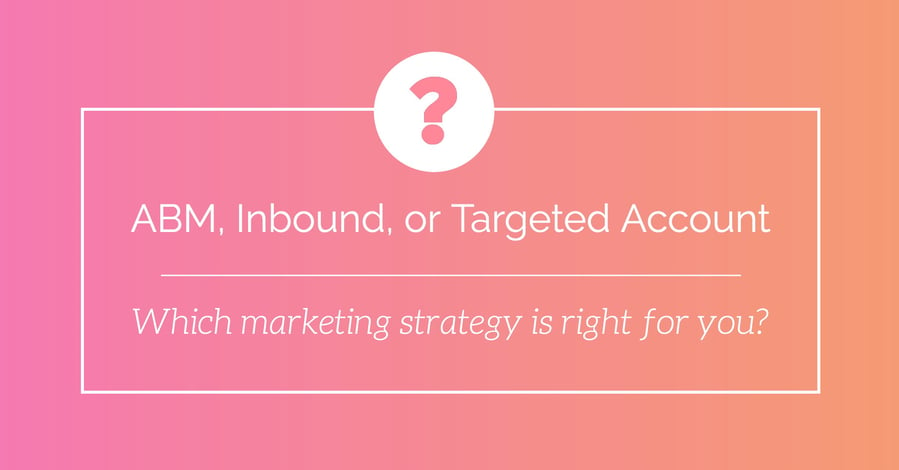ABM, Inbound, Targeted Account: Which marketing strategy is right for you?


If you’re selling something with a considered sales process (meaning it’s not just transactional), then you may have wondered what’s the best way to market your product or service. It can be tempting to pursue a marketing strategy that’s splashy or fun, but it’s more important that your marketing strategy aligns with how you sell. Let’s look at three marketing strategies to see when each one might be the right choice:
Inbound marketing strategy
Imagine you work for a professional services company that sells to any business with 20 or more salespeople; this constitutes a pretty large total addressable market. When you’re developing marketing assets, you can tailor your messaging to address common problems those companies have. This is the idea behind an inbound marketing strategy.
When you use an inbound strategy, odds are good that you’ll actually pull in some people that aren’t a good fit, but that’s part of the process. With a pure inbound approach, you’re going to focus on people’s needs, and then assess fit as they move through the funnel.
In the above example, a marketing team might put together a guide to scaling sales teams, or a checklist on good territory design, or something that appeals to companies right around that 20 salesperson mark. A company with 10 salespeople might want to download that and get into your sales funnel. Does that mean you’ve done something wrong? No, you’ve just brought in someone who isn’t a good fit (yet). You can mark them as unqualified or for nurturing and move along.
Account-based marketing (ABM)
Nearly at the other end of the spectrum of marketing strategies is account-based marketing. Let’s say you have a complex enterprise solution that affects multiple departments. Because of its complexity, your target market is going to be the Fortune 1000 companies. So your target account list is only ever going to have 1000 accounts on it.
Within that list, there could be companies that are a better or worse fit. So you may group the companies based on those factors to separate your top priority companies from lower-priority ones. While an inbound strategy may involve creating content that’s broadly applicable to a wide swath of potential business, an account-based marketing strategy means staying laser-focused on the specific accounts you’re hoping to close, and tailoring your messaging to their needs.
Once you start a conversation with any of these companies, you’ll have to market your offering to multiple people within the organization. Instead of just talking to a single decision maker, you may need to get buy-in from an executive sponsor, a financial buyer, an end-user, and technical buyer, for example. Collectively, they’ll make a decision. With a strong ABM strategy, you’ll have a specific marketing plan for each person on the team, and a good way to track who’s responding and who hasn’t. All this data can help your sales team decide which accounts have a lot of interest versus which ones still need more time.
Targeted account strategy
The third way is a hybrid: the targeted account strategy. This one has elements of both inbound and ABM, and can complement either. The targeted account strategy is similar to ABM in that you’re going to still start with a list of companies that you want to target. This list might be all of the people who are a good fit, or just could be a starting target, but it’s going to help you focus your sales and marketing activities.
Instead of trying to think about marketing to the entire universe of potential prospects, this list will give an idea of who your message should appeal to; if it happens to bring other people in as well, that’s great. The sales team will prioritize contacts with the people on the target list, but they also won’t turn away other people who reach out after encountering your helpful content.
This can be an appealing strategy for many companies, especially those without a mature sales and marketing program in place. It creates focus and flexible structure, and for professional services companies, it can be hugely beneficial. Many of these firms don’t like to specialize, or have difficulty doing so.
A targeted account strategy is a great way to experiment. Instead of having to go all in on new branding and positioning, you can test the market and see what the response is.
Any of these three strategies may be a great fit for your organization. Decide which one is best for your particular goals, and take steps to make sure your organization is set up to support it so that you can build a strong foundation for future revenue growth.
Considering making a move to Account-Based Marketing? Download a copy of our presentation to help you think through all the details.






